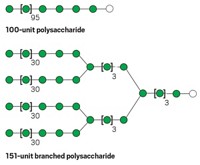Advertisement
Grab your lab coat. Let's get started
Welcome!
Welcome!
Create an account below to get 6 C&EN articles per month, receive newsletters and more - all free.
It seems this is your first time logging in online. Please enter the following information to continue.
As an ACS member you automatically get access to this site. All we need is few more details to create your reading experience.
Not you? Sign in with a different account.
Not you? Sign in with a different account.
ERROR 1
ERROR 1
ERROR 2
ERROR 2
ERROR 2
ERROR 2
ERROR 2
Password and Confirm password must match.
If you have an ACS member number, please enter it here so we can link this account to your membership. (optional)
ERROR 2
ACS values your privacy. By submitting your information, you are gaining access to C&EN and subscribing to our weekly newsletter. We use the information you provide to make your reading experience better, and we will never sell your data to third party members.
Synthesis
Longest Synthetic Oligosialic Acids
Carbohydrate Chemistry: Achievement could aid design of antibacterial vaccines
by Stu Borman
September 21, 2011

Synthetic chains of sialic acids are now available in sizes that are four times longer than ever before.
α-Oligosialic acids are found on surfaces of some pathogenic bacteria and are considered promising components for carbohydrate vaccines that might prime the human immune system to attack deleterious invaders. Synthetic versions could be used in such vaccines and could also help researchers better understand the biological roles of natural α-oligosialic acids, which are found in mammals and on bacteria that cause meningitis, septicemia, and urinary tract infections.
Current vaccines against meningitis and septicemia contain α-oligosialic acids purified from natural sources, which are often heterogeneous in length or contaminated with other antigens—factors that can impair efficacy and cause side effects.
Synthesis could avoid these problems but has proved quite difficult. Until now, the longest synthetic α-oligosialic acids have been tetrasaccharides, whereas α-oligosialic acids need eight or more units to be biologically active.
Now, associate research fellow Chung-Yi Wu and president Chi-Huey Wong of Academia Sinica, Taipei, and coworkers have synthesized pure α-oligosialic acids two, four, six, eight, ten, and twelve units long (Angew. Chem. Int. Ed., DOI: 10.1002/anie.201101794). They succeeded by developing a convergent block synthesis (in which small units are made and joined) with the right protecting group and leaving group to ensure α-only sialylation. “The reagent reported in the paper is the first one with this property,” Wong says. Academia Sinica postdoc Kuo-Ching Chu has already used one of the new α-oligosialic acids to create a candidate vaccine to treat meningitis and septicemia.
Organic chemist Cristina De Meo of Southern Illinois University, Edwardsville, who specializes in sialic acid synthesis, comments that “building oligosialic acids in high yields and maintaining the desired α-stereoselectivity for every step of the synthesis is definitively an extremely important achievement. This is clearly an important milestone in the synthesis of oligosialic acids that can lead to a better understanding of their biological functions or the design of therapeutics.”





Join the conversation
Contact the reporter
Submit a Letter to the Editor for publication
Engage with us on Twitter